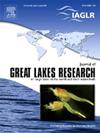Stable isotope analysis of western Lake Superior predatory fishes, part one: Trophic niche overlap
IF 2.5
3区 环境科学与生态学
Q3 ENVIRONMENTAL SCIENCES
引用次数: 0
Abstract
Characterizing food web interactions between introduced and native fish predators is important to quantify niche overlap, assess predator–prey balance, and support fisheries management. Lake Superior provides an ideal setting to investigate potential trophic overlap between native top predators, lake trout (Salvelinus namaycush) and walleye (Sander vitreus), and a diverse assemblage of introduced salmonids. Angler-caught fish were used to measure trophic position and niche overlap between predatory fishes in the western arm of Lake Superior based on carbon and nitrogen stable isotope ratios (δ13C, δ15N). Within a species, we did not find consistent differences in either δ13C or δ15N values by sex, collection year, capture location, or length. Among species, the range in δ15N values was >5 ‰, indicating that these species occupy ∼2 trophic positions, with dietary reliance ranging from primarily invertebrates to primarily fish, whereas the range in δ13C values indicated dietary reliance on a mix of pelagic and benthic prey. Combined, the δ13C and δ15N values revealed siscowet lake trout as the apex predator having a distinct trophic niche, while walleye and lean lake trout were intermediate trophic position predators with overlapping isotopic niches, and introduced salmonids were the lowest trophic position predators with overlapping trophic niches. Overlapping trophic niches indicated similar resource reliance and habitat occupancy among native lake trout and walleye, as well as among introduced salmonids, but less so between native and introduced predators.
苏必利尔湖西部掠食性鱼类的稳定同位素分析,第一部分:营养生态位重叠
表征外来和本地鱼类捕食者之间的食物网相互作用对于量化生态位重叠、评估捕食者-猎物平衡和支持渔业管理具有重要意义。苏必利尔湖提供了一个理想的环境来调查本地顶级捕食者,湖鳟鱼(Salvelinus namaycush)和白眼鱼(Sander vitreus)之间潜在的营养重叠,以及各种引入的鲑鱼。利用垂钓者捕获的鱼类,利用碳、氮稳定同位素比值(δ13C, δ15N)测定了苏必利尔湖西岸捕食性鱼类间的营养位置和生态位重叠。在一个物种内,我们没有发现性别、采集年份、捕获地点或长度对δ13C和δ15N值的一致差异。在物种中,δ15N值的范围为>;5‰,表明这些物种处于~ 2个营养位置,主要依赖无脊椎动物到鱼类,而δ13C值的范围表明饮食依赖于远洋和底栖动物的混合猎物。δ13C值和δ15N值综合分析表明,长尾湖鳟鱼为顶端捕食者,具有明显的营养生态位,而矮眼湖鳟鱼和瘦湖鳟鱼为中间营养位置捕食者,具有重叠的营养生态位,引进鲑为最低营养位置捕食者,具有重叠的营养生态位。重叠的营养生态位表明,本地湖鳟鱼和白眼鱼以及引进鲑科鱼之间的资源依赖和生境占用相似,但本地和引进捕食者之间的重叠程度较低。
本文章由计算机程序翻译,如有差异,请以英文原文为准。
求助全文
约1分钟内获得全文
求助全文
来源期刊

Journal of Great Lakes Research
生物-海洋与淡水生物学
CiteScore
5.10
自引率
13.60%
发文量
178
审稿时长
6 months
期刊介绍:
Published six times per year, the Journal of Great Lakes Research is multidisciplinary in its coverage, publishing manuscripts on a wide range of theoretical and applied topics in the natural science fields of biology, chemistry, physics, geology, as well as social sciences of the large lakes of the world and their watersheds. Large lakes generally are considered as those lakes which have a mean surface area of >500 km2 (see Herdendorf, C.E. 1982. Large lakes of the world. J. Great Lakes Res. 8:379-412, for examples), although smaller lakes may be considered, especially if they are very deep. We also welcome contributions on saline lakes and research on estuarine waters where the results have application to large lakes.
 求助内容:
求助内容: 应助结果提醒方式:
应助结果提醒方式:


